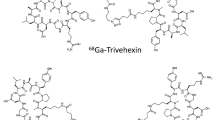The use of tin(II) chloride in amount above its required mole ratio as reducing agent can lead to instability of peptide-based radiopharmaceuticals. In this work, we optimize the radiolabeling conditions, especially tin(II) chloride amount for 99mTc-labeling of one 6-hydrazinonicotinamide (HYNIC) conjugated peptide in the presence of tricine and nicotinic acid (NA). Implementation of this procedure leads to 99mTc-labeling of this HYNIC-conjugated peptide in high radiochemical yield (>95%). By comparison, our experimental results can provide an efficacious strategy for 99mTc-labeling of HYNIC-conjugated biomolecules in the presence of tricine/NA. The resulting 99mTc-labeled peptide, without the need for any chemical modification and pretreatment, shows good stability in saline and human serum. This work can provide a new perspective for 99mTc-labeling of HYNIC-conjugated biomolecules.






Similar content being viewed by others
References
P. Laverman, W. J. McBride, R. M. Sharkey, et al., Comp. Radiopharm., 57(4), 219 – 223 (2014).
C. Dong and Z. Liu, Curr. Med. Chem., 21(1), 139 – 152 (2014).
S. M. Okarvi, Med. Res. Rev., 24(3), 357 – 397 (2004).
I. Dijkgraaf, O. C. Boerman, W. J. Oyen, et al., Anti-Cancer Agents Med. Chem., 7(5), 543 – 551 (2007).
F. Rezazadeh and N. Sadeghzadeh, Chem. Biol. Drug. Des., 93(3), 205 – 221 (2019).
M. Gotthardt, O. C. Boermann, T. M. Behr, et al., Curr. Pharm. Des., 10(24), 2951 – 2963 (2004).
K. Ju, J. Lee, H. ur Rehman, et al., Nucl. Eng. Technol., 51(1), 176 – 189 (2019).
W. C. Eckelman, M. Bonardi, and W. A. Volkert, Nucl. Med. Biol., 35(5), 523 – 527 (2008).
D. Shamshirian, M. Erfani, D. Beiki, et al., Iran. J. Pharm. Res: IJPR., 15(3), 349 – 360 (2016).
R. C. King, M. B.-U. Surfraz, S. C. Biagini, et al., Dalton. Trans., 43, 4998 – 5007 (2007).
L. K. Meszaros, A. Dose, S. C. Biagini, et al., Inorg. Chim. Acta, 363(6), 1059 – 1069 (2010).
S. Srivastava, G. Meinken, T. Smith, et al., Int. J. Appl. Radiat. Isot., 28(1 – 2), 83 – 95 (1977).
S. Chakraborty, S. Das, R. Chakravarty, et al., J. Labelled Comp. Radiopharm., 62(12), 823 – 834 (2019).
S. Kaihani and N. Sadeghzadeh, J. Labelled Comp. Radiopharm., 63(14), 582 – 596 (2020).
C. Decristoforo and S. J. Mather, Nucl. Med. Biol., 26(4), 389 – 396 (1999).
C. Mohan, Buffers. A guide for the preparation and use of buffers in biological systems, Calbiochem (2003), pp. 20 – 21.
D. D. Perrin, Buffers for pH and Metal Ion Control, Springer Science & Business Media (2012).
D. M. Bers, C. W. Patton, and R. Nuccitelli, Methods Cell. Biol., 99, 1 – 26 (2010).
C. Decristoforo, L. Melendez-Alafort, J. Sosabowski, et al., J. Nucl. Med., 41(6), 1114 – 1119 (2000).
C. Decristoforo, B. Faintuch-Linkowski, A. Rey, et al., Nucl. Med. Biol., 33(8), 945 – 952 (2006).
P. Laverman, M. Béhé,W. J. Oyen, et al., Bioconjug. Chem., 15, 561 – 568 (2004).
Author information
Authors and Affiliations
Corresponding author
Rights and permissions
Springer Nature or its licensor (e.g. a society or other partner) holds exclusive rights to this article under a publishing agreement with the author(s) or other rightsholder(s); author self-archiving of the accepted manuscript version of this article is solely governed by the terms of such publishing agreement and applicable law.
About this article
Cite this article
Kaihani, S., Sadeghzadeh, N. Effect of Tin(II) Chloride Amount on 99mTc-Labeling of One 6-Hydrazinonicotinamide-Conjugated Peptide in the Presence of Tricine/Nicotinic Acid. Pharm Chem J 56, 1075–1081 (2022). https://doi.org/10.1007/s11094-022-02756-2
Received:
Published:
Issue Date:
DOI: https://doi.org/10.1007/s11094-022-02756-2




